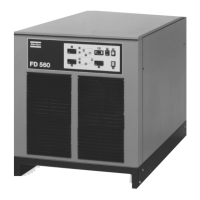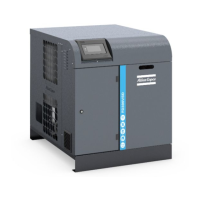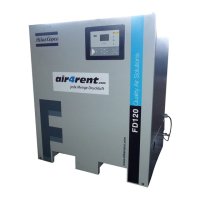2920 1371 00
20
Oil-free Air Division Instruction book
3.3 During operation
At regular intervals check:
1. Pressure dewpoint temperature gauge (P1-Fig. 10).
2. That condensate trap (1-Figs. 4 and 6-Figs. 5) is operative.
If the operation is doubtful, flush the trap as per point 3 1).
3. Regularly open manual drain valve(s) (2-Fig. 8) for approx.
10 seconds to discharge condensate and possible impurities.
3.4 Stopping (Fig. 10)
1. Flush the condensate trap (see section 3.3).
2. Close the dryer air outlet valve. It is not necessary to close
its air inlet valve. Only if the air net requires so, open the
by-pass valve and close the air inlet valve.
3. Press button (S1) to the stand-by position. The dryer stops.
Voltage on lamp (H1) remains alight. The crankcase heater
remains switched on. Disconnect the dryer from the mains
if it is going to be out of service for a long period or when
maintenance is needed.
Leave the isolating switch closed if the dryer has to remain
stand-by.
4. On water-cooled dryers, close the cooling water shut-off
valves.
3.5 Possible causes of unstable or too
high pressure dewpoint
temperature
1. Dryer overload
- Compressed air flow exceeds capacity of dryer
- Working pressure too low
- Air inlet temperature too high
- Ambient temperature too high
- On water-cooled dryers, insufficient cooling water flow
2. Refrigeration system problems or maladjustment
- Maladjustment of the refrigerant expansion valve (7-
Fig. 4b and 9-Fig. 5b)
- Shortage of refrigerant in circuit through leakage
- Condenser externally clogged (air-cooled dryers)
- Malfunctioning of fan control switch (S3-Fig. 4b) on
air-cooled dryers or malfunctioning of the cooling water
regulating valve (3-Fig. 5a) on water-cooled dryers
Note: The pressure dewpoint temperature will deviate from
nominal when the nominal conditions are exceeded, e.g. a
pressure dewpoint temperature of +7°C can be considered as
normal if the air flow, the air inlet temperature or the ambient
temperature is higher than nominal.
1) - Not necessary when an electronic interval drain has been
installed.
- At initial start-up the condensate trap must be flushed more
frequently.
H1. Indicator lamp, voltage on
H2. Indicator lamp, dryer on
H3. Alarm indicator lamp, high
pressure dewpoint temperature
P1. Pressure dewpoint temperature
gauge
P2. Temperature gauge, air inlet
P3. Temperature gauge, evaporating
temperature
P4. Temperature gauge, condensing
temperature
S1. Run/stand-by button
The numbered items are pictographs
for:
1. Temperature
2. Air inlet
3. Air outlet
4. Air/air heat exchanger
5. Air/refrigerant heat exchanger
6. Condensate trap
7. Pressure dewpoint temperature
8. Refrigerant expansion valve
9. Start/Stop button
10. Alarm
11. Voltage on
12. Refrigerant compressor
13. Condenser
14. Refrigerant liquid dryer
Fig. 10. Instrument panel

